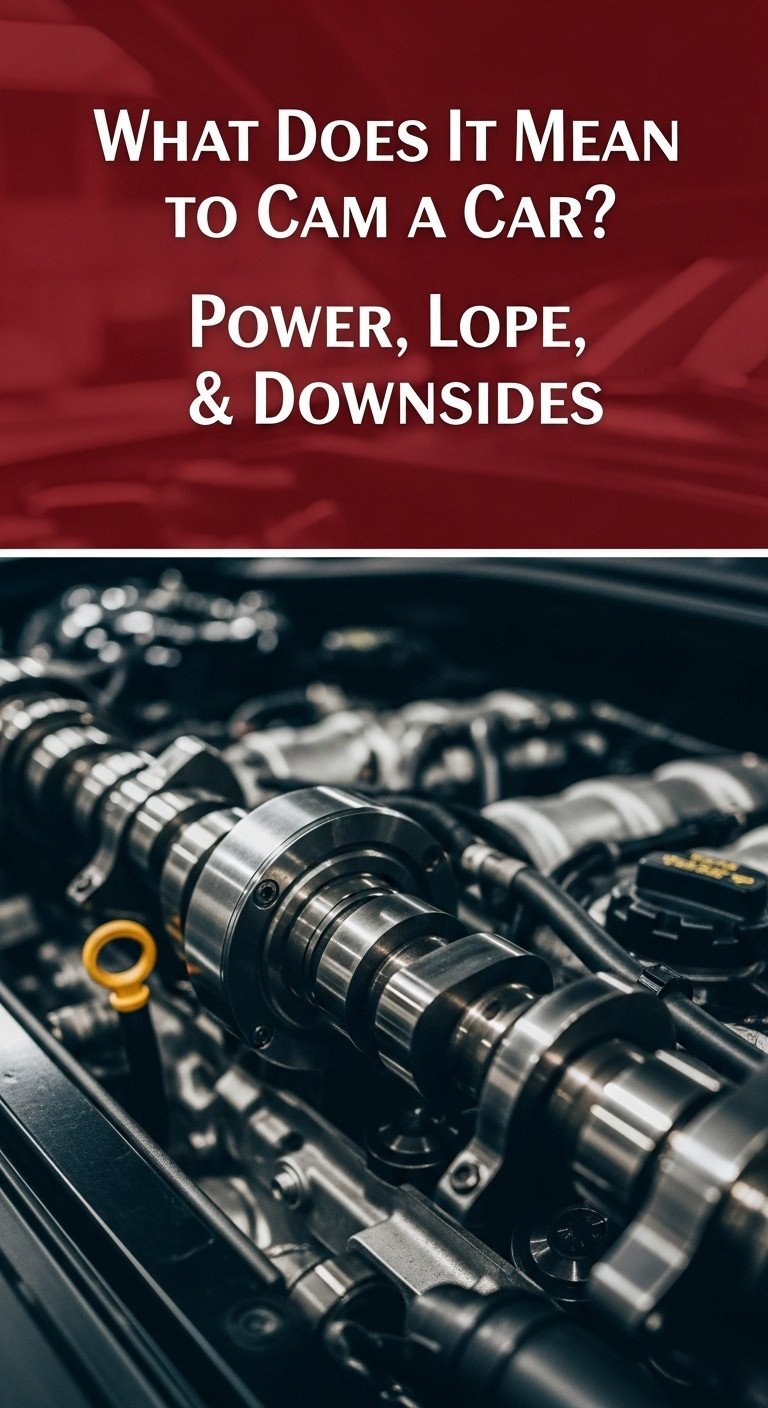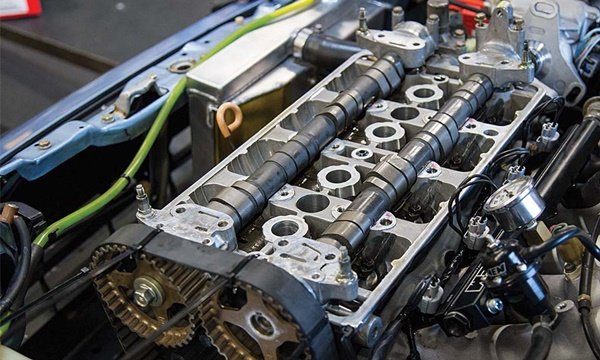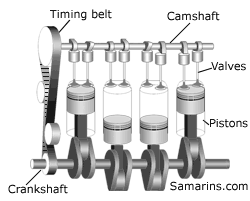Ever heard a car with a choppy, aggressive idle and wondered what makes it sound that way? You were likely hearing a cammed engine. Many car enthusiasts chase this specific sound and the power that comes with it, but the term “camming a car” often brings up more questions than answers. You might be wondering what this modification actually does, if the performance gains are worth it, and what the hidden downsides are for a daily-driven vehicle.
To “cam a car” is to replace the engine’s factory-installed camshaft with a high-performance version. This modification changes how and when the engine’s valves open and close, with the primary goals of significantly increasing horsepower and achieving a distinct, aggressive engine sound known as a “cam lope.”
Leveraging extensive analysis of authoritative automotive data, this guide breaks down exactly what it means to cam a car. We will explore the core mechanics, the alluring benefits, the critical trade-offs, and the practical costs involved. This will give you the complete picture you need to understand one of the most popular and impactful engine modifications in the enthusiast world.
Key Facts
- Significant Power Gains: A performance camshaft can boost an engine’s output by 45 horsepower or more, as highlighted by data from Philkotse.com.
- The “Lope” Sound Explained: The iconic choppy idle sound is not just for show; it’s the audible result of altered valve timing that creates a “burst sequence” in the engine’s firing, a detail explained in SSForums.com discussions.
- The Major Trade-Off: The biggest downside is a reduction in low-RPM efficiency and torque, which can negatively impact daily drivability and make the car feel sluggish in stop-and-go traffic.
- Typical Part Cost: According to Philkotse.com, the cost for a performance camshaft part in 2025 typically ranges from $130 to $420 USD (approximately Php 7,500 to Php 24,000), not including the significant labor costs for installation.
- Average Lifespan: A standard camshaft is a durable component, with an average lifespan of around 130,000 kilometers, though a high-performance cam in a modified engine may experience different wear patterns.
What Does It Mean to “Cam a Car”? A Complete Guide
To “cam a car” is to replace the engine’s stock camshaft with a performance version to change how and when the engine’s valves open and close, aiming to increase horsepower and achieve a distinct, aggressive engine sound. This modification is one of the most fundamental ways to alter an engine’s character and performance output.

At its core, a camshaft is a shaft inside an internal combustion engine with a series of egg-shaped lobes. As it rotates, these lobes actuate the intake and exhaust valves, allowing the critical air-fuel mixture to enter the combustion chambers and exhaust gases to exit. According to automotive resource Cars.com, the camshaft’s rotation is precisely synchronized with the crankshaft to ensure the entire combustion cycle happens in perfect sequence. When you “cam a car,” you are fundamentally rewriting those instructions for a more aggressive, power-oriented goal.
A performance camshaft is an aftermarket part installed to alter engine valve timing and lift, with the goal of increasing horsepower and creating an aggressive engine sound. Data from sources like Philkotse.com and SSForums.com confirms these are the primary motivations for the modification.

How Camming an Engine Actually Works
Camming works by installing a camshaft with more aggressive lobes that (1) push valves open further (increased lift), (2) keep them open longer (extended duration), and (3) adjust their timing to force more air and fuel into the engine, boosting power. Think of it like breathing. A stock cam is like normal breathing, while a performance cam is like taking deeper, longer breaths to get more air when you’re running hard.
This is achieved by changing three key variables of the camshaft’s lobe profile:
- Increased Valve Lift: The lobes on a performance camshaft are taller, meaning they physically push the engine’s valves open further into the cylinder. This creates a larger opening, allowing a greater volume of the air-fuel mixture to rush in and more exhaust gases to be forced out.
- Extended Valve Duration: The lobes are also wider, which means they hold the valves open for a longer period of the engine’s cycle. This extended duration gives the engine more time to “breathe,” maximizing the amount of air and fuel it can take in before combustion.
- Altered Valve Timing: Performance cams also change when the valves open and close in relation to the piston’s movement. This optimization is designed to improve the engine’s volumetric efficiency—its ability to move the air-fuel mixture through the cylinders—especially at high engine speeds (RPMs).
By getting more air and fuel into the engine and getting exhaust out more efficiently, the engine is able to produce more powerful combustion cycles, resulting in a significant increase in overall horsepower.
The Allure: Key Benefits of Camming Your Car
The primary reasons to cam a car are for a major boost in horsepower (often 45+ hp), better engine performance at high speeds, and achieving the iconic throaty, choppy idle sound enthusiasts desire. These benefits directly address the core motivations for performance-oriented car enthusiasts.
- Significant Horsepower Increase: This is the number one performance benefit. By improving the engine’s ability to breathe at high RPMs, a performance camshaft unlocks power that the stock component was designed to restrict for the sake of efficiency and smooth operation.
According to data from Philkotse.com, a well-chosen camshaft can boost an engine’s power output by 45 horsepower or more, a substantial gain from a single component swap.
- Improved High-RPM Performance: Stock engines are often tuned for low-to-mid-range power to make daily driving smooth and efficient. A performance cam shifts the engine’s power band upwards. This means the car will pull much harder and feel significantly faster at higher engine speeds, making it ideal for racing or spirited driving scenarios.
- The Iconic “Cam Lope” Sound: For many, the sound is as important as the power. That ‘cam lope’ isn’t just for show—it’s the audible result of valve timing designed for maximum high-RPM power. The altered timing creates an overlap where intake and exhaust valves are slightly open at the same time, causing a rough, choppy, or “throaty” idle. Automotive forums like SSForums.com describe this sound as a “burst sequence,” which is highly desirable in muscle car and tuner communities.
The Trade-Offs: Downsides and Considerations of Camming
The main drawbacks are a loss of power and efficiency at low speeds, making daily driving more difficult, significantly worse fuel economy, and the potential for serious engine damage if the cam is not chosen or installed correctly. It’s a modification that gives with one hand and takes away with the other.
Pro Tip: Before choosing a cam, be honest about your driving style. If you spend most of your time in city traffic, an aggressive cam can make your car frustrating to drive.
Here are the key considerations you must weigh:
- Worse Drivability at Low Speeds: Because performance cams are optimized for high RPMs, they are very inefficient at low RPMs. This results in reduced low-end torque, which is the force that gets your car moving from a stop. The car may feel sluggish, jerky, or difficult to drive smoothly in stop-and-go traffic.
- Increased Fuel Consumption: An engine modified to take in more air needs more fuel to maintain the proper air-fuel ratio. As confirmed by automotive resource Philkotse.com, this change in airflow dynamics almost always leads to worse fuel economy, so you’ll be visiting the gas station more often.
- Potential for Engine Damage: This is the most serious risk. An improperly chosen or installed camshaft can cause severe problems. If the timing between the valves and pistons becomes incorrectly synchronized, it can lead to catastrophic engine damage. Furthermore, the wrong cam profile can cause issues like pre-ignition (fuel igniting too early) or detonation (uncontrolled explosions in the cylinder), both of which can destroy an engine over time.
- Emissions and Legality: In many regions, altering a vehicle’s camshaft can cause it to fail emissions tests. The valve overlap that creates the desirable sound also allows unburnt fuel to escape into the exhaust, which is a major concern for environmental regulations.
Camshafts in Different Engines: OHC vs. OHV
Camshafts are key to both modern OHC (cam in head) and traditional OHV (cam in block) engines, but their location and number can differ significantly. Understanding your engine type is crucial before considering such a modification.
- Overhead-Camshaft (OHC) Engines: In the majority of modern cars, the camshafts are located in the cylinder head, directly above the valves. This design is more efficient at high RPMs. Many of these are DOHC (Dual Overhead Camshaft) engines, which use two separate camshafts per bank of cylinders—one for the intake valves and one for the exhaust valves.
- Overhead-Valve (OHV) Engines: Also known as pushrod engines, this older design places a single camshaft inside the engine block. It uses long rods (pushrods) and rocker arms to actuate the valves located up in the cylinder head. While less common today, OHV engines are still found in many larger American V8s used in trucks and muscle cars.
Regardless of the configuration, the principle of camming the car remains the same: swapping the factory camshaft for a performance version to alter valve lift and duration.

Cost and Reliability: The Practical Realities
Expect to pay between $130 and $420 for the camshaft itself, not including installation. The primary risks to its lifespan are timing belt failure and poor oil lubrication. A key factor in camshaft life is proper lubrication. Regular, high-quality oil changes are non-negotiable for a modified engine.
The cost of the part is only the beginning. Camshaft installation is a labor-intensive job that requires significant engine disassembly, making labor costs often much higher than the part itself.
| Item | Estimated Cost (Part Only) – 2025 |
|---|---|
| Performance Camshaft | $130 – $420 USD |
| (Equivalent in PHP) | (Php 7,500 – Php 24,000) |
Note: Prices are estimates and do not include labor, supporting parts (lifters, springs), or tuning.
Camshafts themselves are robust, but they can fail. The most common causes of failure are not due to the part itself but related components:
- Timing Chain/Belt Issues: A broken timing belt or a stretched timing chain will disrupt the engine’s synchronization and can cause the pistons to collide with the valves, leading to catastrophic failure.
- Lack of Lubrication: Insufficient oil flow is a major killer of camshafts. It causes excessive wear on the cam lobes and lifters, eventually leading to failure.
- Physical Damage: In rare cases of other major engine failures, a loose connecting rod or other internal part can strike the camshaft, causing it to crack or break.
To ensure your engine is ready for this upgrade, investing in a high-quality performance camshaft kit can provide all the necessary components for a reliable installation.
FAQs About Camming a Car
Here are answers to some of the most common questions people have when they first learn about what it means to cam a car.
Does camming a car always increase horsepower?
Yes, the primary goal is to significantly increase horsepower, but this power gain is most noticeable at higher RPMs and often results in less power at lower speeds. Data from Philkotse.com suggests gains can be 45 horsepower or more. However, this power comes from shifting the engine’s efficiency from the low-RPM range (used for daily driving) to the high-RPM range (used for racing).
Why does a cammed car have a choppy idle?
The choppy idle, or “lope,” is caused by altered valve timing which disrupts the engine’s smooth, continuous firing sequence at idle, creating a “burst sequence” sound. This happens because performance cams often have a high degree of “valve overlap,” where the intake and exhaust valves are open simultaneously for a brief moment, which is inefficient at idle but helps with airflow at high speeds.
Will camming my car ruin the engine?
It can, but only if done incorrectly. A properly selected and installed camshaft is safe, but improper installation can lead to incorrect timing, pre-ignition, and potential engine damage. Choosing a cam that is too aggressive for your engine’s other components or failing to synchronize it correctly can lead to catastrophic failure. Professional installation and tuning are highly recommended.
Does camming a car affect fuel economy?
Yes, camming a car almost always results in worse fuel economy because the engine is optimized for high-RPM power, not low-speed efficiency, and requires more fuel. The same design features that create more power by allowing more air and fuel into the engine naturally lead to increased consumption, a point confirmed by data from Philkotse.com.
Final Summary: Is Camming Your Car the Right Choice for You?
Ultimately, the decision to cam your car comes down to its primary use. Weigh the thrill of high-RPM power against the practical needs of your daily drive. Camming a car is a classic trade-off: you sacrifice everyday practicality for a major boost in peak performance and an aggressive, head-turning sound. It’s a modification that pushes a vehicle further into the “specialty” or “weekend toy” category and away from being a reliable, efficient daily commuter.
If your goal is to build a track car, a drag racer, or a show car where maximum power and sound are the top priorities, then camming your car is one of the most effective ways to achieve that. However, if you rely on your vehicle for daily transportation in heavy traffic, the loss of low-end torque and poor fuel economy can quickly turn the dream into a frustrating reality.
Here are the final takeaways to consider:
- Gain: Significant horsepower increase, primarily at high engine speeds.
- Gain: A desirable, choppy, and aggressive “cam lope” engine sound.
- Loss: Reduced low-end torque, making the car feel sluggish from a stop.
- Loss: Worse fuel economy and potential issues passing emissions tests.
- Risk: Potential for engine damage if the camshaft is not selected, installed, and tuned professionally.
Before you proceed, be honest about your goals, your budget for both parts and expert labor, and your tolerance for the compromises involved.
Last update on 2025-12-02 / Affiliate links / Images from Amazon Product Advertising API













